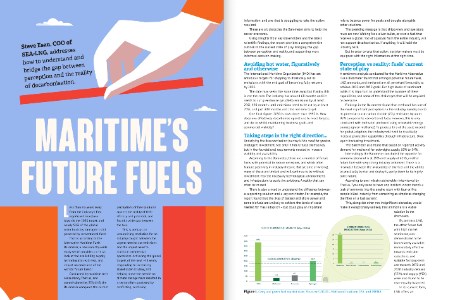[ad_1]
Less than six years away from the industry’s first significant milestone towards the 2050 target, and nearly 50% of the global order book (by tonnage) is still powered by conventional fuels.
That is according to the Alternative Maritime Fuels Barometer, a new industry-wide study which provides a critical look at the availability, supply, technological readiness, and impact on emissions of the world’s ‘future fuels’.1
Conducted by maritime tech consultancy, Thetius, and commissioned by SEA-LNG, the Barometer compares the current perceptions of fuel solutions against the reality of their efficacy and potential, and found a wide gap between the two.
This is perhaps an unsurprising revelation for an industry caught between the urgent need to cut emissions and the urgent need to maintain commercial operations. Achieving the global targets of the next ~25 years, responding to increasing stakeholder scrutiny, and helping move the needle on climate change have resulted in a sector often paralysed by conflicting, confusing information, and one that is struggling to take the action required.
These are all obstacles the Barometer aims to help the sector overcome.
Using insights from key stakeholders and the latest scientific findings, the report provides a comprehensive outlook to the current state of play. Bridging the gap between perception and reality, and supporting more informed decision-making.
Avoiding hot water, figuratively and otherwise
The International Maritime Organization (IMO) has set ambitious targets for shipping to drastically cut its emissions, with the end goal of becoming fully net zero by 2050.
The date may seem like some time away but frankly, this is not the case. The industry has around 68 months until it needs to cut greenhouse gas (GHG) emissions by at least 20%; 189 months until emissions need to be cut by at least 70%; and just 309 months until the net-zero target.
One final figure: 2050 is now closer than 1997 is. How does one effectively decarbonise operations to meet targets, and do so whilst maintaining business goals and commercial viability?
Taking steps in the right direction…
Underlying the decarbonisation journey is the need for greater, intelligent investment. Not only in future fuels themselves, but in the foundational requirements needed to increase viability and availability.
According to the Barometer, there are a number of future fuels with potential to reduce emissions, and which often feature positively in industry rhetoric. But (at time of writing), many of these are limited and will continue to be without investment into the necessary technological advancements and infrastructure to scale the solutions. A reality that can often be missed.
There is also a need to understand the difference between a supporting solution and a key contributor. For example, the report found that the likes of battery and shore power and some biofuels are unlikely to achieve the levels of scale needed for mass adoption – but could play an important role to balance power for peaks and troughs alongside other solutions.
The presiding message is that shipowners and operators must act now. Waiting for a silver bullet, or even a fuel that receives a global nod of approval from the entire industry, will not support decarbonisation. If anything, it will hold the industry back.
But in order to take that action, decision-makers must be equipped with the right information at the right time.
Perception vs reality: fuels’ current state of play
A sentiment analysis conducted for the Maritime Alternative Fuels Barometer found that amongst potential future fuels, LNG, ammonia, and methanol are all perceived favourably to achieve 2030 and 2050 goals. But high levels of sentiment aside, it is important to understand the nuances of these capabilities, and some of the challenges that will be required to overcome.
Findings in the Barometer found that methanol has one of the most significant perceptions in the industry, namely due to its potential to cut carbon dioxide (CO2) emissions by up to 95% compared to conventional fuels. However, this is only consistent with methanol produced using renewable energy sources (green methanol). To produce this at the scale needed for global adoption, the industry will need to drastically increase production capabilities through infrastructure. Once again increasing investment.
The Barometer also found that based on reported activity demand for methanol far outweighs supply, 66% to 34%.
Interestingly, the Barometer concluded the opposite for ammonia (demand is at 39% and supply at 61%), another future fuel with very strong industry sentiment. There is a mismatch between the availability of the fuel and the ability to practically bunker and deploy it, partly down to its highly toxic nature.
According to one industry stakeholder interviewed by Thetius, “you only need to have one incident where there’s a leak of ammonia into the engine room with four or five people killed instantly from something as simple as changing the filter on a fuel system.” This, alongside other not insignificant obstacles, would make it exceptionally unlikely that ammonia is a viable solution in the short-term.
By contrast, LNG, the other future fuel with high market sentiment, was demonstrated to be immediately available, immediately effective towards emission reductions, and suitable for long-term use towards 2030 and 2050. Industry demand (55%) and supply (45%) were also found to be near-equally balanced.
Enjoyed what you’ve read so far? Read the full article and the rest of the June issue of LNG Industry by registering today for free!
Read the article online at: https://www.lngindustry.com/special-reports/17062024/maritimes-future-fuels/
[ad_2]
Source link
